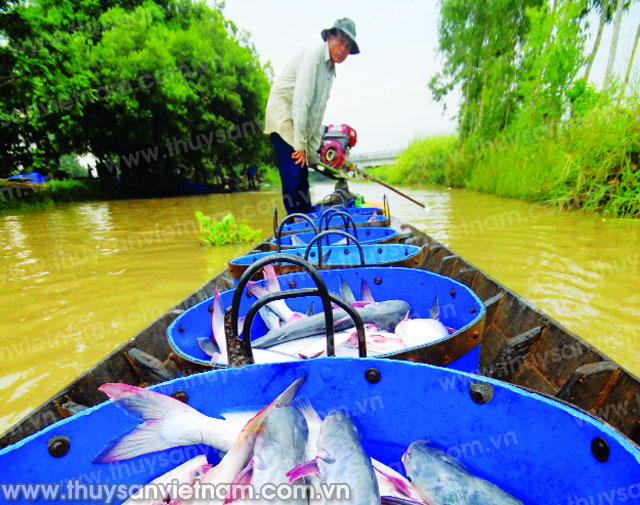Regardless of difficulties in Tra fish aquaculture, among its 10 years working, Thoi An Fisheries Cooperative (O Mon district, Can Tho city) had nine years getting profit and only one facing losses.
Dare to think, dare to do
Founded on November 23rd, 2003, Thoi An Fisheries Cooperative had 10 members, a 3,000 m2 pond, value at 40 million VND, with a charter capital at 500 million VND. Each share was worth 500,000 VND and Nguyen Ngoc Hai was selected head of the cooperative.
At first, the cooperative raised fish in their only pond but needed over 1 billion VND. Due to the lack of budget, the cooperatives members had to contribute more. With good luck and the abundance of water owing to being located near Hau river, which was convenient to have clean water supply, their fish grew fast and had almost no diseases. After six months, the cooperatives had 150 tons of Tra fish output, and got a total profit of over 300 million VND.
Some previously reluctant people then enthusiastically decided to invest more. The membership increased got to 20. The cooperative rent two more hectares of water surface. Other crops were consecutively successful. The total farming area was expanded to 10 ha, and their harvest was over 3,000 tons/year. Their revenue went up from only 1.3 billion VND in 2003 to 300 billion VND in 2010. In the same year, the coopertive registed for the second time with charter captital at 5.7 billion VND, about 11 times compared with the initial one.

Model of Tra fish farming, Thoi An Cooperative, O Mon district, Can Tho city – Photo: Gia Bao
New style of business
“The old-style cooperative caused constraints to members because sometimes their demands or ideas were not considered by the Board of Directors. In the new-style cooperative, members voluntarily make their decision to invest and the management becomes easier. The biggest advantage is the transparency of finance, salaries and costs. After every crop, profits are divided based on the rates of investment. The Board of Directors get their salary of 0.6 percent of profit before dividend calculations,” said Hai.
The cooperative used to face difficulties and challenges of cross- relationship among members. It was in 2005, the only year of losses (600 million VND). Some members were confused when there was a change in raw Tra fish supply market; more businesses invested in Tra fish, building their own farming area and being active to supply raw fish to processing plants. Many small-scaled aquacuture families faced losses.
To deal with the situation, the Board encouraged membet to cut costs, improve their farming techniques, find suppliers of materials, feed, veterinary medicine with low prices and sell their raw fish directly to businesses. Able to foresee the continuous fluctuation, the cooperative signed a contract with Hung Vuong Corp on selling Tra fish before doing the aquacuture. In return, they assured to control the quality, quantity and deadline.
In 2008, the cooperative and Hung Vuong Corp signed a new contract, on the basis of cooperative investment. The company bears costs (of breeding fish, veterinary medicine, salaries for staff, etc) while the cooperative is responsible for doing the aquaculture, obey regulations of food safety, and get profit on the quantity of output and savings from costs. Hence, they did not have to invest money and take fewer risks.
For the past five years, the cooperative has been able to keep their profit of 1,500 – 2,000 VND/kg. In 2013, they had an output of over 5,000 tons raw fish and got over 10 billion VND of profit.
|
>> “There should be more links between cooperative and businesses in the supply chain production. This is the vertical production link – a condition for the restructuring period of Tra fish production links,” said Nguyen Ngoc Hai, Director of Thoi An cooperative. |